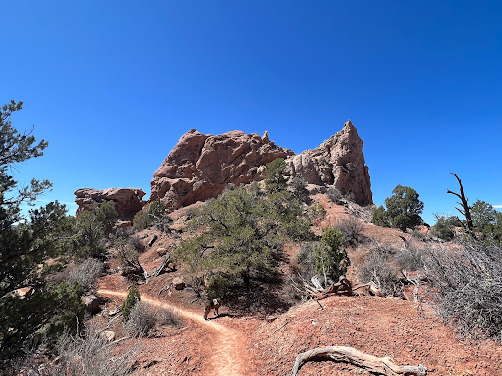Ruby's Inn RV Park and Campground - Bryce City, Utah
Bryce Canyon National Park is located in southwestern Utah. The major feature of
the park is Bryce Canyon, which despite its name, is not a canyon, but a
collection of giant natural amphitheaters along the eastern side of
the Paunsaugunt Plateau. Bryce is distinctive due to geological structures
called hoodoos, formed by frost weathering and stream erosion of
the river and lake bed sedimentary rocks. The red, orange, and white
colors of the rocks provide spectacular views for park visitors. Bryce Canyon
National Park is much smaller and sits at a much higher elevation than nearby Zion
National Park. The rim at Bryce varies from 8,000 to 9,000 feet.
The Bryce Canyon area was settled by Mormon pioneers in the 1850's and was named after Ebenezer Bryce, who homesteaded in the area in 1874. The area around Bryce Canyon was originally designated as a national monument by President Warren G. Harding in 1923 and was redesignated as a national park by Congress in 1928. The park covers 35,835 acres and receives substantially fewer visitors than Zion National Park (nearly 4.3 million in 2016) or Grand Canyon National Park (nearly 6 million in 2016), largely due to Bryce's more remote location. .
Rainbow Point, the highest part of the park at 9,105 feet is
at the end of the 18-mile scenic drive. From there, Aquarius Plateau,
Bryce Amphitheater, the Henry Mountains, the Vermilion Cliffs and
the White Cliffs can be seen. Yellow Creek, where it exits the park
in the north-east section, is the lowest part of the park at 6,620 feet.
Lisa was standing on the side of road where plows have been piling up snow.

Prairie dogs are herbivorous burrowing ground
squirrel’s native to the grasslands of North America. In the United States, they range primarily
to the west of the Mississippi River, though they have also been
introduced in a few eastern locales. Despite the name, they are not actually canines;
prairie dogs, along with the marmots and chipmunks, belong to the squirrel family.
Prairie dogs are considered a keystone species, with their
mounds often being used by other species. Their mound-building encourages grass
development and renewal of topsoil, with rich mineral, and nutrient renewal
in the soil, which can be crucial for soil quality and agriculture. They are
extremely important in the food chain, being important to the diet of many
animals such as the black-footed ferret, swift fox, golden eagle, red
tailed hawk, American badger, and coyote. Other species, such as the golden-mantled
ground squirrel, mountain plover, and the burrowing owl, also rely on
prairie dog burrows for nesting areas. Prairie dogs have some of the most
complex systems of communication and social structures in the animal
kingdom.
The Red Canyon is located just off Highway 12 enroute to Bryce Canyon National Park amid the spectacular red sandstone spires and formations. This area has been called the "most photographed place in Utah". The Red Canyon Trail System is widely known and very popular. Nearby trails include Pink Ledges, Hoodoo, Birdseye and Golden wall. There are many trails open to foot traffic, as well as bicycle, horse and ATV.
Capitol Reef National Park is in south-central Utah. The park is
approximately 60 miles long on its north–south axis and just 6 miles wide on
average. The park was established in 1971 to preserve 241,904 acres of
desert landscape and is open all year. Most people visit the park during May through September because of the weather.
Capitol Reef National Park was designated a national monument in 1937, by President Franklin D. Roosevelt to protect the area's colorful canyons, ridges, buttes, and monoliths; however, it was not until 1950 that the area officially opened to the public. Road access was improved in 1962 with the construction of State Route 24 through the Fremont River Canyon. The drive to the park offers spectacular views, but also ignites some anxiety for the driver. The drops into the canyons were deep and without guard rails or shoulders on the road. There was zero room for error.
Unlike the related white-tailed deer, which is found throughout most of North America, mule deer are only found on the western Great Plains, in the Rocky Mountains, in the southwest United States, and on the west coast of North America.
Kodachrome Basin is a state park in Utah. It is situated 5,800 feet above sea level, 12 miles south of Utah Route 12, and 20 miles southeast of Bryce Canyon National Park.



























































































.JPG)

























































































